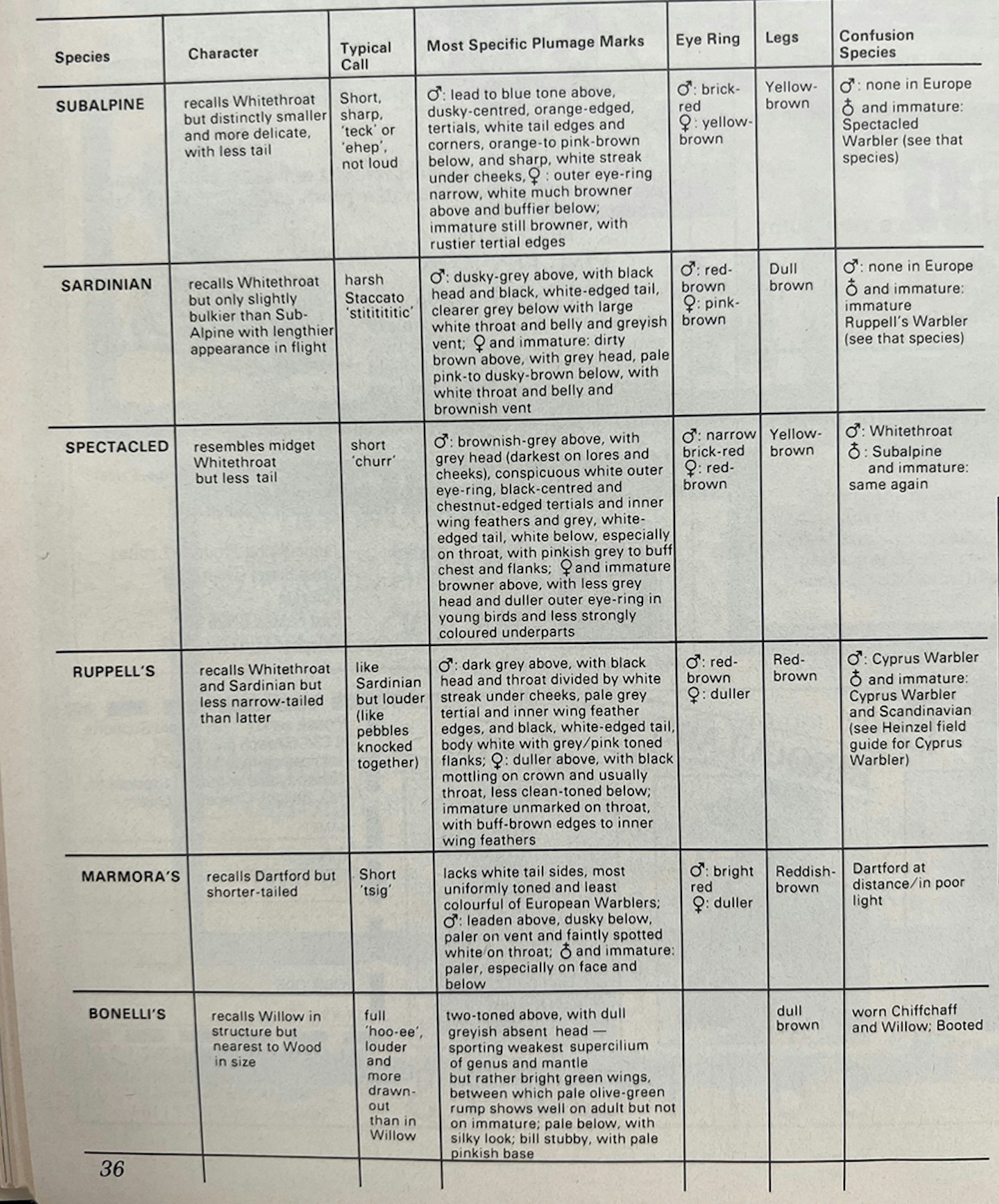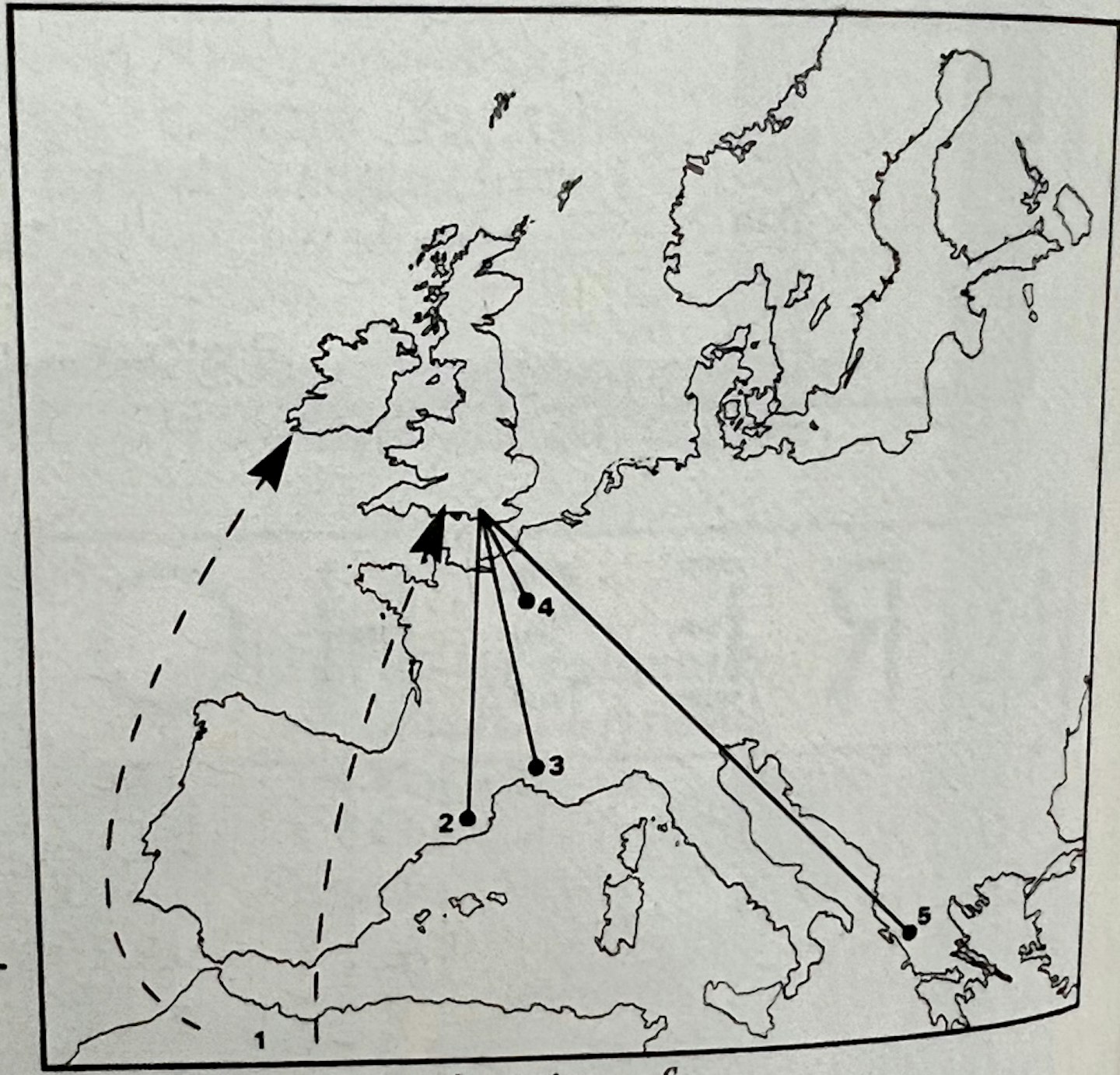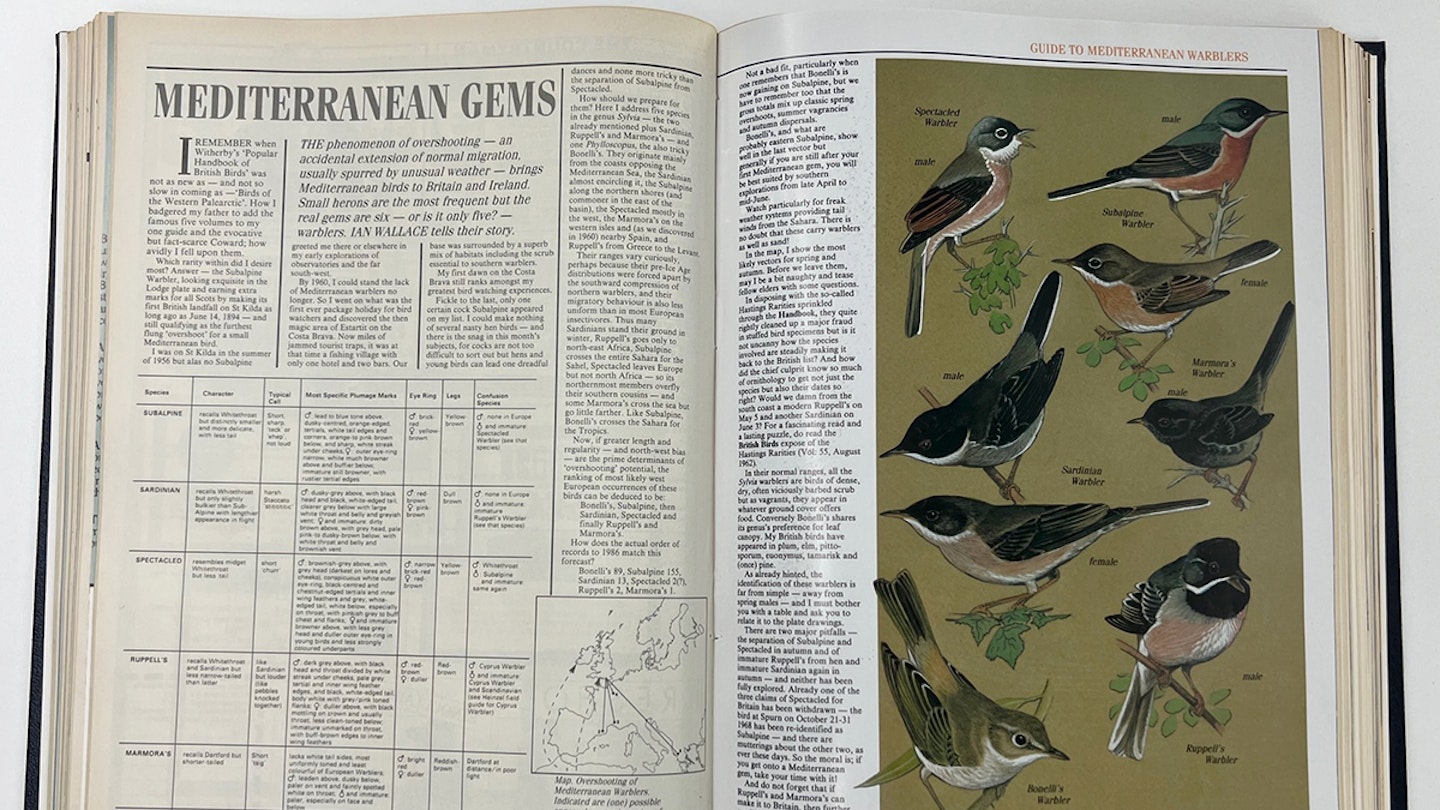Mediterranean Gems
May 1988
The phenomenon of overshooting – an accidental extension of normal migration, usually spurred by unusual weather – brings Mediterranean birds to Britain and Ireland. Small herons are the most frequent but the real gems are six – or is it only five? warblers. Ian Wallace tells their story.

I remember when Witherby's Handbook of British Birds was not as new as and not so slow in coming as – Birds of the Western Palearctic. How I badgered my father to add the famous five volumes to my one guide and the evocative but fact-scarce Coward; how avidly I fell upon them.
Which rarity within did I desire most? Answer – the Subalpine Warbler, looking exquisite in the Lodge plate and earning extra marks for all Scots by making its first British landfall on St Kilda as long ago as June 14, 1894 – and still qualifying as the furthest flung 'overshoot' for a small Mediterranean bird.
I was on St Kilda in the summer of 1956 but, alas, no Subalpine greeted me there or elsewhere in my early explorations of observatories and the far south-west.

By 1960, I could stand the lack of Mediterranean warblers no longer. So I went on what was the first ever package holiday for birdwatchers and discovered the then magic area of Estartit on the Costa Brava. Now miles of jammed tourist traps, it was at that time a fishing village with only one hotel and two bars. Our base was surrounded by a superb mix of habitats including the scrub essential to southern warblers.
My first dawn on the Costa Brava still ranks among my greatest birdwatching experiences.
Fickle to the last, only one certain cock Subalpine appeared on my list. I could make nothing of several nasty hen birds and there is the snag in this month's subjects, for cocks are not too difficult to sort out but hens and young birds can lead one dreadful dances and none more tricky than the separation of Subalpine from Spectacled.
How should we prepare for them? Here I address five species in the genus Sylvia – the two already mentioned plus Sardinian, Rüppell's and Marmora's – and one Phylloscopus, the also tricky Bonelli's. They originate mainly from the coasts opposing the Mediterranean Sea, the Sardinian almost encircling it, the Subalpine along the northern shores (and commoner in the east of the basin), the Spectacled mostly in in 1960) nearby Spain, and Rüppell's from Greece to the Levant.
Their ranges vary curiously, perhaps because their pre-Ice Age distributions were forced apart by the southward compression of northern warblers, and their migratory behaviour is also less uniform than in most European insectivores. Thus many Sardinians stand their ground in winter, Rüppell’s goes only to north-east Africa, Subalpine crosses the entire Sahara for the Sahel, Spectacled leaves Europe but not north Africa – so its northernmost members overfly their southern cousins – and some Marmora's cross the sea but go little farther. Like Subalpine, Bonelli's crosses the Sahara for the Tropics.
Now, if greater length and regularity – and north-west bias – are the prime determinants of 'overshooting' potential, the ranking of most likely west European occurrences of these birds can be deduced to be: Bonelli's, Subalpine, then Sardinian, Spectacled and finally Rüppell’s and Marmora's. How does the actual order of records to 1986 match this forecast? Bonelli's 89, Subalpine 155, Sardinian 13, Spectacled 20, Rüppell’s 2, Marmora's 1.

Not a bad fit, particularly when one remembers that Bonelli's is now gaining on Subalpine, but we have to remember too that the gross totals mix up classic spring overshoots, summer vagrancies and autumn dispersals.
Bonelli's, and what are probably eastern Subalpine, show well in the last vector but generally if you are still after your first Mediterranean gem, you will be best suited by southern explorations from late April to mid-June.
Watch particularly for freak weather systems providing tail winds from the Sahara. There is no doubt that these carry warblers as well as sand!
In the map, I show the most likely vectors for spring and autumn. Before we leave them, may I be a bit naughty and tease fellow elders with some questions.
In disposing with the so-called ‘Hastings Rarities’ sprinkled through the Handbook, they quite rightly cleaned up a major fraud in stuffed bird specimens but is it not uncanny how the species involved are steadily making it back to the British list? And how did the chief culprit know so much of ornithology to get not just the species but also their dates so right? Would we damn from the south coast a modern Rüppell’s on May 5 and another Sardinian on June 3? For a fascinating read and a lasting puzzle, do read the British Birds expose of the Hastings Rarities (Vol: 55, August 1962).
In their normal ranges, all the Sylvia warblers are birds of dense, dry, often viciously barbed scrub but as vagrants, they appear in whatever ground cover offers food. Conversely, Bonelli's shares its genus's preference for leaf canopy. My British birds have appeared in plum, elm, pittosporum, euonymus, tamarisk and (once) pine.
As already hinted, the identification of these warblers is far from simple – away from spring males – and I must bother you with a table and ask you to relate it to the plate drawings.
There are two major pitfalls the separation of Subalpine and Spectacled in autumn and of immature Rüppell's from hen and immature Sardinian again in autumn – and neither has been fully explored. Already one of the three claims of Spectacled for Britain has been withdrawn – the bird at Spurn on 21 to 31 October 1968 has been re-identified as Subalpine – and there are mutterings about the other two, as ever these days.
So the moral is; if you get onto a Mediterranean gem, take your time with it! And do not forget that if Rüppell's and Marmora's can make it to Britain, then further small Sylvias might also do so. Eric Simms, in his 1985 monograph, mentions both Ménétries's and Tristram's as candidates. They and Cyprus must be very unlikely but then my generation were not ready for the amazing Desert either – yet most young birders now expect it one year or other!
2020s update
The ‘Subalpine Warblers’ which occur in the UK have in recent years been ‘split’ to include three species: Eastern Subalpine Warbler, Western Subalpine Warbler and Moltoni’s Warbler (the latter mainly found somewhere in the middle of east and west, in Italy; 10 accepted UK records).
Similarly, Bonelli’s Warbler is now two species: Western and Eastern Bonelli’s Warblers
Even Marmora’s Warbler is now split, so that Marmora’s Warbler occurs on the mainland and Balearic Warbler occurs on the Spanish Mediterranean (Balearic) islands.
There are now seven accepted records of Marmora’s Warbler in the UK (the last being in May 2018). Balearic Warbler is yet to be recorded.
There are to date five records of Rüppell’s Warbler in the UK, the last being in June 1995.
